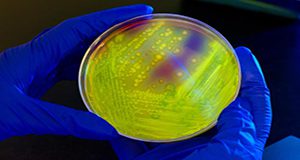Abstract
Healthcare-associated infections are infections that patients can get while receiving medical treatment in a healthcare facility. One opportunistic pathogen, Clostridium difficile, has been getting more attention in recent years because of its association with antibiotic use and a high death rate among the elderly. This 7-page factsheet will provide an overview of Clostridium difficile infection (CDI) with a focus on healthcare-associated infections. Written by Soohyoun Ahn and Amarat H. Simonne and published by the UF/IFAS Department of Food Science and Human Nutrition, January 2018.
http://edis.ifas.ufl.edu/fs253
References
Banas, J. A. 2004. "Virulence properties of Streptococcus mutans." Front Biosci 9:1267-1277. https://doi.org/10.2741/1305
Bassetti, M., G. Villa, and D. Pecori. 2014. "Antibiotic-resistant Pseudomonas aeruginosa: focus on care in patients receiving assited ventilation." Future Microbiol 9:465-474. https://doi.org/10.2217/fmb.14.7
Centers for Disease Control and Prevention (CDC). 2014. "Diseases and organisms in healthcare settings." Last accessed on November 6, 2017. http://www.cdc.gov/HAI/organisms/organisms.html
Centers for Disease Control and Prevention (CDC). 2015. "Clostridium difficile infection information for patients." Last accessed on November 30, 2017. https://www.cdc.gov/hai/organisms/cdiff/cdiff-patient.html
Centers for Disease Control and Prevention (CDC). 2016a. "HAI data and statistics." Last accessed on November 3, 2017. https://www.cdc.gov/hai/surveillance/index.html
Centers for Disease Control and Prevention (CDC). 2016b. "Clostridium difficile infection (CDI) - Prevention primer." Last accessed on November 14, 2017. https://www.cdc.gov/hai/pdfs/toolkits/cdi-primer-2-2016.pdf
Chroneou, A., N. Zias, J. F. Beamis, Jr, and D. E. Craven. 2007. "Healthcare-associated pneumonia: principles and emerging concepts on management." Expert Opin Pharmacother. 8:3117-3131. https://doi.org/10.1517/14656566.8.18.3117
Danziger-Isakov, L. 2014. "Gastrointestinal infections after transplantation." Curr Opin Gastroenterol 30:40-46. https://doi.org/10.1097/MOG.0000000000000016
Dubberke, E. R., and D. N. Gerding. 2011. "Rationale for hand hygiene recommendations after caring for a patient with Clostridium difficile infection." Last accessed on November 30, 2017. https://www.shea-online.org/images/patients/CDI-hand-hygiene-Update.pdf
Hookman, P., and J. S. Barkin. 2009. "Clostridium difficile associated infection, diarrhea and colitis." World J. Gastroenterol. 15:1554-1580. https://doi.org/10.3748/wjg.15.1554
Kelly, C. P., and J. T. Lamont. 2014. "Clostridium difficile in adults: treatment." Last accessed on November 30, 2017. http://www.uptodate.com/contents/clostridium-difficile-in-adults-treatment
Kerr, K. G. and A. M. Snelling. 2009. "Pseudomonas aeruginosa: a formidable and ever-present adversary." J. Hosp. Infect. 73:338-344. https://doi.org/10.1016/j.jhin.2009.04.020
Klevens, R. M., J. R. Edwards, C. L. Richards, Jr., T. C. Horan, R. P. Gaynes, D. A. Pollock, and D. M. Cardo. 2002. "Estimating health care-associated infections and deaths in US hospitals. Public Health Rep. 122:160-166. https://doi.org/10.1177/003335490712200205
Knoop, F. C., M. Owens, and I. C. Crocker. 1993. "Clostridium difficile: clinical disease and diagnosis." Clin. Microbiol. Rev. 6:251-265. https://doi.org/10.1128/CMR.6.3.251
Kochanek, K. D., S. L. Murphy, J. Xu, and B. Tejada-Vera. 2016. "Deaths: final data for 2014." Natl Vital Stat Rep 65:1-122. Last accessed on November 30, 2017. https://www.cdc.gov/nchs/data/nvsr/nvsr65/nvsr65_04.pdf
Kuehn, B. M. 2011. "Scientists seek strategies to prevent Clostridium difficile infections." JAMA 306:1849-1850. https://doi.org/10.1001/jama.2011.1569
Kyi, C., M. D. Hellmann, J. D. Wolchok, P. B. Chapman, and M. A. Postow. 2014. "Opportunistic infections in patients treated with immunotherapy for cancer." J. Immunother Cancer. 2:19. https://doi.org/10.1186/2051-1426-2-19
Leffler, D. A. and J. T. Lamont. 2015. "Clostridium difficile infection." N. Engl. J. Med. 372:1539-1548. https://doi.org/10.1056/NEJMra1403772
Lessa, F. C., L. G. Winston, L. C. McDonald, and Emerging Infections Program C. difficile Surveillance Team. 2015. "Burden of Clostridium difficile infection in the United States." N. Engl. J. Med. 372:2369-2370. https://doi.org/10.1056/NEJMc1505190
Loo, V. G., P. Brassard, and M. A. Miller. 2016. "Household transmission of Clostridium difficile to family members and domestic pets." Infect. Control Hosp. Epidemiol. 37:1342-1348. https://doi.org/10.1017/ice.2016.178
Magill, S. S., J. R. Edwards, W. Bamberg, Z. G. Beldavs, G. Dumyati, M. A. Kainer, R. Lynfield, R. et al. 2014. "Multistate point-prevalence survey of health care-associated infections." N. Engl. J. Med. 370:1198-1208. https://doi.org/10.1056/NEJMoa1306801
Napolitano, L. M. and C. E. Edmiston Jr. 2017. "Clostridium difficile disease: Diagnosis, pathogenesis, and treatment update." Surgery 162:325-348. https://doi.org/10.1016/j.surg.2017.01.018
Norén, T. 2010. "Clostridium difficile and the disease it causes." Methods Mol. Biol. 646:9-35. https://doi.org/10.1007/978-1-60327-365-7_2
Pagano, L., and M. Caira. 2012. "Risks for infection in patients with myelodysplasia and acute leukemia." Currn Opin Infect Dis. 25:612-618. https://doi.org/10.1097/QCO.0b013e328358b000
Pépin, J., L. Valiquette, and B. Cossette. 2005. "Mortality attributable to nosocomial Clostridium difficile-associated disease during an epidemic caused by a hypervirulent strain in Quebec." CMAJ. 173:1037-1042. https://doi.org/10.1503/cmaj.050978
Rohlke, F. and N. Stollman. 2012. "Fecal microbiota transplantation in relapsing Clostridium difficile infection." Therap. Adv. Gastroenterol. 5:403-420. https://doi.org/10.1177/1756283X12453637
Scott, R. D. II. 2009. "The direct medical costs of healthcare-associated infections in US hospitals and the benefits of prevention." Last accessed on November 6, 2017. http://www.cdc.gov/hai/pdfs/hai/scott_costpaper.pdf
Sehulster, L., and R. Y. W. Chinn. 2003. "Guidelines for environmental infection control in health-care facilities: recommendations of CDC and the Healthcare Infection Control Practices Advisory Committee (HICPAC)." MMWR 52:1-42.
Siegel, J. D., E. Rhinehart, M. Jackson, L. Chiarello, and the Healthcare Infection Control Practices Advisory Committee. 2007. "2007 Guideline for isolation precautions: preventing transmission of infectious agents in healthcare settings." Last accessed on November 30, 2017. https://www.cdc.gov/infectioncontrol/pdf/guidelines/isolation-guidelines.pdf https://doi.org/10.1016/j.ajic.2007.10.007
Squellati, R. 2017. "Evidence-based practice in the treatment for antibiotic-associated diarrhea in the intensive care unit." Crit. Care Nurs. Clin. North Am. https://doi.org/10.1016/j.cnc.2017.10.008. https://doi.org/10.1016/j.cnc.2017.10.008
Steiner, C., M. Barrett, and Y. Sun. 2015. "HCUP Projections: Clostridium Difficile Hospitalizations 2004-2015. 2015. HCUP Projections Report #2015-02." Last accessed on Nov 15, 2017. https://www.hcup-us.ahrq.gov/reports/projections/2015-02.pdf
Stone, N. E., L. C. Sidak-Loftis, J. W. Sahl, A. J. Vazquez, K. B. Wiggins, J. D. Gillece et al. 2016. "More than 50% of Clostridium difficile isolates from pet dogs in Flagstaff, USA, carry toxigenic genotypes." PLOS One 11:e0164504. https://doi.org/10.1371/journal.pone.0164504
Teter, J, Florida Department of Health, Division of Disease Control and Health Protection. 2015. "Clostridium difficile diagnoses during hospitalizations, Florida, 2008-2013." Last accessed on November 28, 2017. http://www.floridahealth.gov/diseases-and-conditions/clostridium-difficile/_documents/clostridium-difficile-diagnoses-during-hospitalizations.pdf.
Tredget, E. E., H. A. Shankowsky, R. Rennie, R. E. Burrell, and S. Logsetty. 2004. "Pseudomonas infections in the thermally injured patient." Burns 30:3-26. https://doi.org/10.1016/j.burns.2003.08.007
Unless otherwise specified, articles published in the EDIS journal after January 1, 2024 are licensed under a Creative Commons Attribution-NonCommercial-NoDerivs 4.0 International (CC BY-NC-ND 4.0) license.

